hi,我是熵减,见字如面。
昨天我们用ChatGPT来设计一个账号系统,并尝试输出:模型表,类关系图,序列图,状态图等常用的架构设计中常用的元素。
今天,我们继续向更高层级延伸一下,看ChatGPT能不能更进一步释放工程师的生产力,创造更多的可能性。
所以,这次我们就来尝试用ChatGPT,来构建账号系统的C4模型的架构图啦。
由于ChatGPT不能直接输出图像,所以我们转化为用Mermaid的脚本,通过markdown的方式输出,再用支持Mermaid渲染的工具,将图片显示出来。
生成数据库初始化SQL
我们首先来试试,生成数据库初始化SQL吧。
提示:将以上账号系统的数据模型,生成MySQL数据库的SQL
ChatGPT:
-- 创建表:Account
CREATE TABLE Account (
id INT PRIMARY KEY,
username VARCHAR(50) NOT NULL,
password VARCHAR(50) NOT NULL,
email VARCHAR(50),
phone_number VARCHAR(20),
state VARCHAR(20),
email_ver BOOLEAN DEFAULT false,
phone_ver BOOLEAN DEFAULT false,
created_at DATETIME,
updated_at DATETIME
);
-- 创建表:EmailVerification
CREATE TABLE EmailVerification (
id INT PRIMARY KEY,
token VARCHAR(50) NOT NULL,
expired_at DATETIME,
account_id INT,
FOREIGN KEY (account_id) REFERENCES Account(id)
);
-- 创建表:PhoneVerification
CREATE TABLE PhoneVerification (
id INT PRIMARY KEY,
token VARCHAR(50) NOT NULL,
expired_at DATETIME,
phone_number VARCHAR(20),
account_id INT,
FOREIGN KEY (account_id) REFERENCES Account(id)
);
-- 创建表:ThirdPartySocialAccount
CREATE TABLE ThirdPartySocialAccount (
id INT PRIMARY KEY,
provider VARCHAR(20) NOT NULL,
provider_id VARCHAR(50) NOT NULL,
account_id INT,
FOREIGN KEY (account_id) REFERENCES Account(id)
);
-- 创建表:LoginRecord
CREATE TABLE LoginRecord (
id INT PRIMARY KEY,
account_id INT,
login_at DATETIME,
FOREIGN KEY (account_id) REFERENCES Account(id)
);
以上SQL语句可以在MySQL数据库中创建相应的表,包括Account、EmailVerification、PhoneVerification、ThirdPartySocialAccount和LoginRecord五个表,并设置它们之间的关联关系。
直接输出C4 Diagram
接下来我们直接尝试其是否可以输出系统的C4模型的代码吧。
提示:对于系统架构图,用Mermaid's c4 diagram是非常有效的,接下来,我们需要开始构建c4 模型的Mermaid脚本,并用markdown
ChatGPT:
好的,以下是用Mermaid's C4 Diagram构建系统架构图的Mermaid脚本,并用markdown格式输出:
## C4 Model for Account System
### Level 1: System Context Diagram
title Account System - System Context Diagram
actor User
User -> AccountSystem: Use
### Level 2: Container Diagram
title Account System - Container Diagram
AccountSystem -> AccountService: Uses
AccountSystem -> EmailService: Uses
AccountSystem -> PhoneService: Uses
AccountSystem -> ThirdPartyService: Uses
AccountSystem -> Database: Uses
AccountService -> Database: Reads/Writes
EmailService -> Database: Reads/Writes
PhoneService -> Database: Reads/Writes
ThirdPartyService -> Database: Reads/Writes
### Level 3: Component Diagram
title Account System - Component Diagram
AccountSystem --> AccountService: Manages Accounts
AccountSystem --> EmailService: Sends Email
AccountSystem --> PhoneService: Sends SMS
AccountSystem --> ThirdPartyService: Interacts with Social Platforms
AccountService --> Account: Accesses Account Data
EmailService --> EmailVerification: Validates Email
PhoneService --> PhoneVerification: Validates Phone Number
Account --> PasswordSecurity: Manages Passwords
Account --> LoginRecord: Records Login Information
虽然给出了完整的代码,但在我的vscode的插件中,无法渲染出正确的结果图。
我推测由于ChatGPT训练的时间是21年的,所以其给出的代码版较低,而Mermaid近期升级了对C4模型的脚本规范,所以,我试图提升ChatGPT升级一下:
提示:这不是最新版的,请用Mermaid的最新版的C4 Diagrams脚本,再次输出
ChatGPT:
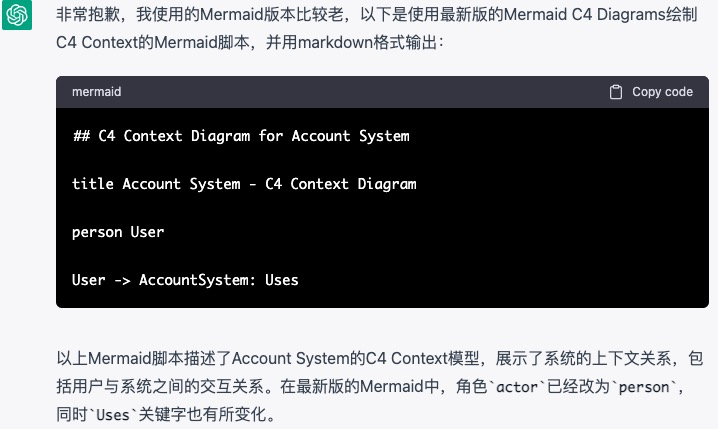
输出的结果,依然在我的渲染插件中无法展示。
所以,我尝试换了一种方法,来让其帮我继续做C4模型图,这也是我发现的一个大惊喜:
你给ChatGPT一个内容模版,它立马就会学会应用,而且效果惊人。
下面我们继续来看新方法的过程。
C4模型实验
C4Context视图
我输入的提示:下面,我要给你一个最新版本的Mermaid C4 Diagrams脚本案例,你要记住哦
ChatGPT:好的,尽管跟我分享吧。
我将从Mermaid官网上复制的C4Context代码输入给了ChatGPT:
C4Context
title System Context diagram for Internet Banking System
Enterprise_Boundary(b0, "BankBoundary0") {
Person(customerA, "Banking Customer A", "A customer of the bank, with personal bank accounts.")
Person(customerB, "Banking Customer B")
Person_Ext(customerC, "Banking Customer C", "desc")
Person(customerD, "Banking Customer D", "A customer of the bank,
with personal bank accounts.")
System(SystemAA, "Internet Banking System", "Allows customers to view information about their bank accounts, and make payments.")
Enterprise_Boundary(b1, "BankBoundary") {
SystemDb_Ext(SystemE, "Mainframe Banking System", "Stores all of the core banking information about customers, accounts, transactions, etc.")
System_Boundary(b2, "BankBoundary2") {
System(SystemA, "Banking System A")
System(SystemB, "Banking System B", "A system of the bank, with personal bank accounts. next line.")
}
System_Ext(SystemC, "E-mail system", "The internal Microsoft Exchange e-mail system.")
SystemDb(SystemD, "Banking System D Database", "A system of the bank, with personal bank accounts.")
Boundary(b3, "BankBoundary3", "boundary") {
SystemQueue(SystemF, "Banking System F Queue", "A system of the bank.")
SystemQueue_Ext(SystemG, "Banking System G Queue", "A system of the bank, with personal bank accounts.")
}
}
}
BiRel(customerA, SystemAA, "Uses")
BiRel(SystemAA, SystemE, "Uses")
Rel(SystemAA, SystemC, "Sends e-mails", "SMTP")
Rel(SystemC, customerA, "Sends e-mails to")
UpdateElementStyle(customerA, $fontColor="red", $bgColor="grey", $borderColor="red")
UpdateRelStyle(customerA, SystemAA, $textColor="blue", $lineColor="blue", $offsetX="5")
UpdateRelStyle(SystemAA, SystemE, $textColor="blue", $lineColor="blue", $offsetY="-10")
UpdateRelStyle(SystemAA, SystemC, $textColor="blue", $lineColor="blue", $offsetY="-40", $offsetX="-50")
UpdateRelStyle(SystemC, customerA, $textColor="red", $lineColor="red", $offsetX="-50", $offsetY="20")
UpdateLayoutConfig($c4ShapeInRow="3", $c4BoundaryInRow="1")
ChatGPT:

提示:请按照上面给的案例,输出我们修改后的账号系统的C4Context的Mermaid脚本,用markdown输出
ChatGPT输出:
C4Context
title Account System Context Diagram
Enterprise_Boundary(EB, "Account System Boundary") {
System(AccountSystem, "Account System", "Allows users to manage their accounts, passwords, and login sessions.")
User(User, "User", "A user of the account system.")
System_Ext(MailSystem, "Email System", "The internal email system.")
System_Ext(SMS, "SMS System", "The system that sends SMS messages for 2FA.")
AccountSystem --> User
AccountSystem --> MailSystem
AccountSystem --> SMS
}
BiRel(User, AccountSystem, "Uses")
Rel(AccountSystem, MailSystem, "Sends emails")
Rel(AccountSystem, SMS, "Sends SMS messages for 2FA")
UpdateElementStyle(User, $fontColor="red", $bgColor="grey", $borderColor="red")
UpdateRelStyle(User, AccountSystem, $textColor="blue", $lineColor="blue", $offsetX="5")
UpdateRelStyle(AccountSystem, MailSystem, $textColor="blue", $lineColor="blue", $offsetY="-10", $offsetX="-50")
UpdateRelStyle(AccountSystem, SMS, $textColor="blue", $lineColor="blue", $offsetY="10", $offsetX="-50")
代码渲染后为:
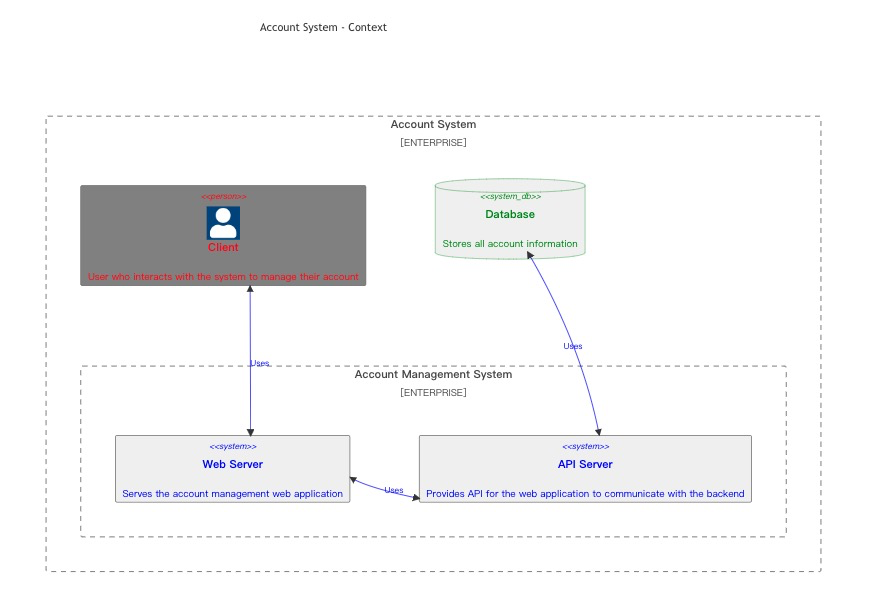
实验成功,那接下来的其他的C4模型,就可以如法炮制啦。
C4Container视图
提供Mermaid官网的demo后,就可以提示:
请按照上面给的案例,输出我们我们要处理账号系统C4Container的Mermaid脚本,用markdown输出
ChatGPT输出代码为:
C4Container
title Container diagram for Account System
System_Ext(identity_provider, "Identity Provider", "An external identity provider, such as Auth0 or Okta", $tags="v1.0")
Person(user, User, "A user of the system, with a registered account", $tags="v1.0")
Container_Boundary(c1, "Account System") {
Container_Ext(web_app, "Web Application", "Java, Spring MVC", "Delivers the static content and the account system SPA")
Container(spa, "Single-Page App", "JavaScript, Angular", "Provides all the account system functionality to users via their web browser")
ContainerDb(database, "Database", "SQL Database", "Stores user registration information, hashed auth credentials, access logs, etc.")
ContainerDb_Ext(api, "API Application", "Java, Docker Container", "Provides account system functionality via API")
}
Rel(user, web_app, "Uses", "HTTPS")
UpdateRelStyle(user, web_app, $offsetY="60", $offsetX="90")
Rel(user, spa, "Uses", "HTTPS")
UpdateRelStyle(user, spa, $offsetY="-40")
Rel(web_app, spa, "Delivers")
UpdateRelStyle(web_app, spa, $offsetX="130")
Rel(spa, api, "Uses", "async, JSON/HTTPS")
Rel_Back(database, api, "Reads from and writes to", "sync, JDBC")
Rel(identity_provider, user, "Provides authentication for")
UpdateRelStyle(identity_provider, user, $offsetX="-45")
Rel(api, identity_provider, "Uses", "async, OAuth2/OpenID Connect")
UpdateRelStyle(api, identity_provider, $offsetY="-60")
脚本渲染后图片为:
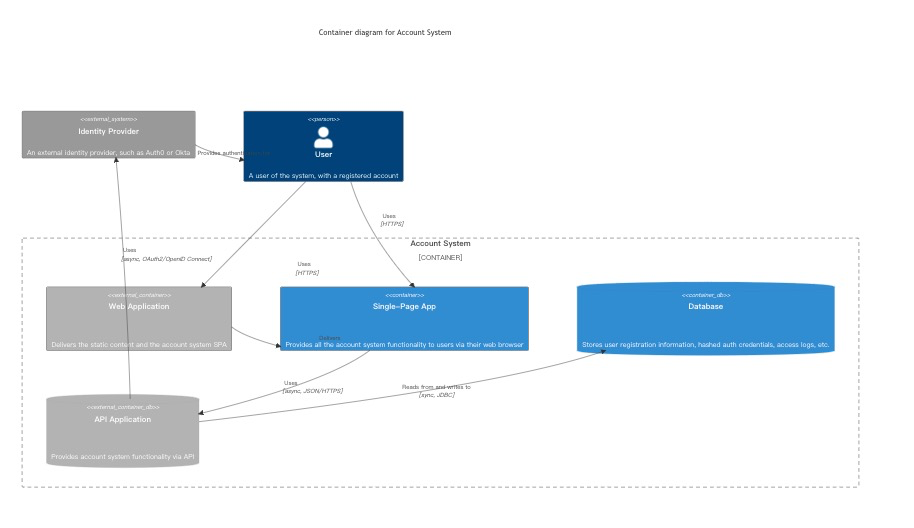
C4Component视图
提供Mermaid官网的demo后,就可以提示:
请按照上面给的案例,输出我们我们要处理账号系统C4Component的Mermaid脚本,用markdown输出
ChatGPT输出代码渲染后图片为:

C4Dynamic 视图
提供Mermaid官网的demo后,就可以提示:
请按照上面给的案例,输出我们我们要处理账号系统C4Component的Mermaid脚本,用markdown输出
ChatGPT输出代码渲染后图片为:
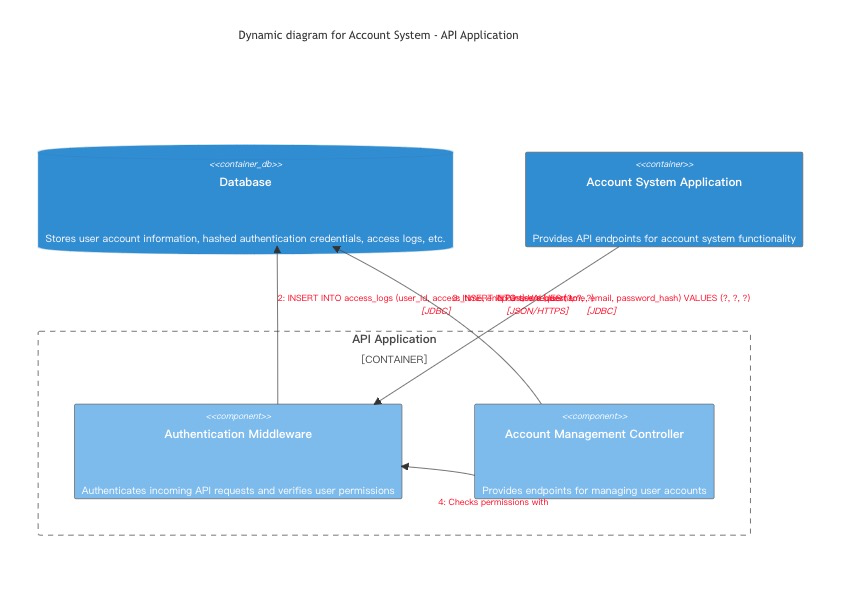
C4Deployment视图
提供Mermaid官网的demo后,就可以提示:
请按照上面给的案例,输出我们我们要处理账号系统C4Deployment的Mermaid脚本,用markdown输出
ChatGPT输出代码渲染后图片为:
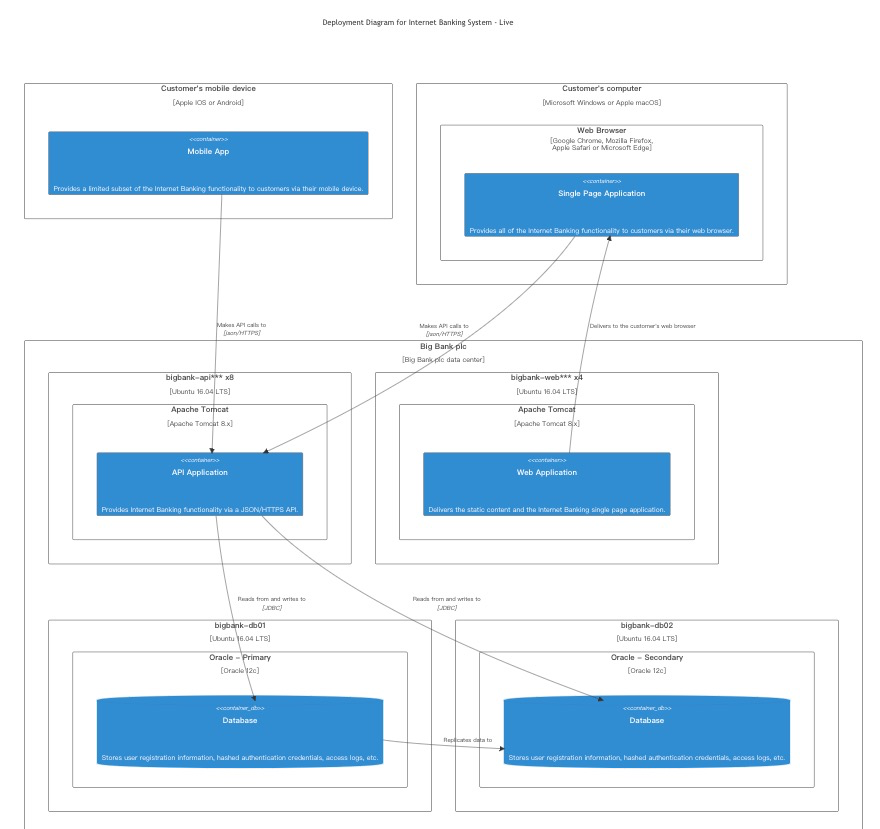
备注:在ChatGPT熟悉了2-3次过程后,只要输入模版,其就会自动给出结果啦,连提示都可以省略了,重复工作完全自动化啦。
复杂状态试图
在今天的实验中,最后尝试做了一个负责的系统状态转化图,具体如下:
提示:在账号系统中的EmailVerification,PhoneVerification,ThirdPartyBinding的状态发生变化时,Account中对应信息变化的 Mermaid 脚本
ChatGPT:
以下是在账号系统中的EmailVerification,PhoneVerification,ThirdPartyBinding的状态发生变化时,Account中对应信息变化的Mermaid脚本:
给出的代码如下:
stateDiagram-v2
state "Account" as account {
state "EmailVerified" as emailVerified
state "PhoneVerified" as phoneVerified
state "ThirdPartyBound" as thirdPartyBound
[*] --> emailVerified : initialize
[*] --> phoneVerified : initialize
[*] --> thirdPartyBound : initialize
emailVerified --> phoneVerified : Email verified
emailVerified --> thirdPartyBound : Third-party bound
phoneVerified --> thirdPartyBound : Third-party bound
emailVerified --> emailVerified : Re-verify email
phoneVerified --> phoneVerified : Re-verify phone
thirdPartyBound --> thirdPartyBound : Unbind third-party
emailVerified --> * : Email unverified
phoneVerified --> * : Phone unverified
thirdPartyBound --> * : No third-party
}
这个脚本包含了四个节点,分别表示账户,电子邮件验证,电话验证和第三方绑定。每个节点有对应的状态,包括已验证,无效,已绑定和未绑定。节点之间的关系用箭头表示,例如账户有电子邮件验证,电话验证和第三方绑定。在状态发生变化时,节点的颜色也会相应地改变。
代码渲染图片:

继续尝试,输出以上变化的序列图,提示:
ChatGPT:
以下是在账号系统中的EmailVerification,PhoneVerification,ThirdPartyBinding的状态发生变化时,Account中对应信息变化的序列图的Mermaid脚本:
sequenceDiagram
participant Account
participant EmailVerification
participant PhoneVerification
participant ThirdPartyBinding
Account ->> EmailVerification: VerifyEmail(email, code)
activate EmailVerification
EmailVerification -->> Account: EmailVerified(email)
deactivate EmailVerification
Account ->> PhoneVerification: VerifyPhone(phone, code)
activate PhoneVerification
PhoneVerification -->> Account: PhoneVerified(phone)
deactivate PhoneVerification
Account ->> ThirdPartyBinding: BindThirdParty(thirdPartyAccount)
activate ThirdPartyBinding
ThirdPartyBinding -->> Account: ThirdPartyBound(thirdPartyAccount)
deactivate ThirdPartyBinding
Account ->> ThirdPartyBinding: UnbindThirdParty(thirdPartyAccount)
activate ThirdPartyBinding
ThirdPartyBinding -->> Account: ThirdPartyUnbound(thirdPartyAccount)
deactivate ThirdPartyBinding
上面的序列图描述了Account对象和三个相关对象(EmailVerification,PhoneVerification和ThirdPartyBinding)之间的交互,以处理EmailVerification,PhoneVerification和ThirdPartyBinding状态变化的情况。
在这个序列图中,Account对象向EmailVerification,PhoneVerification和ThirdPartyBinding发送请求,以更新与它们关联的信息。每个参与者在收到请求后执行其操作,并通过消息传递结果将结果返回给Account对象,以通知其信息已被更新。
渲染后的图片为:

写在最后
今天的实验,就这么多啦,希望对你有启发哦。
在日常的系统设计中,创造系统图表是一件不太容易,也非常繁琐的事情,而ChatGPT则可以很好的帮我们处理这些问题,让我们可以节省不少的时间和精力哦。
在实验的过程中,也可以发现ChatGPT存在这个各种可能性,只要我们能给出不错的提示,提供有效的上下文,他就可以快速的学习,并将此结果有效的利用在接下来的任务之中。
ChatGPT还有很多未知的能力,值得每一个人去探索,保持好奇心吧。